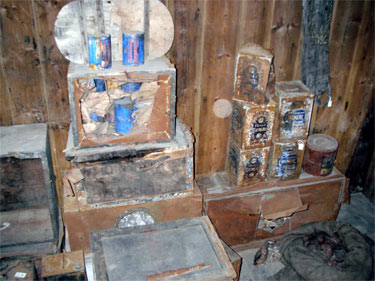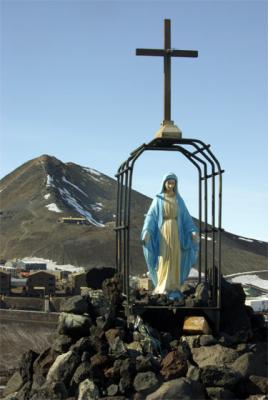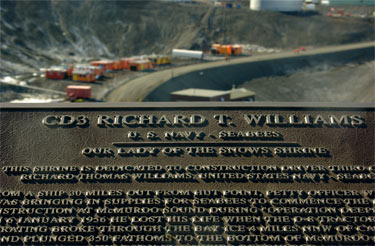In 8th grade, my favorite teacher of all time, Mr. Slusarski - the crazy Pole, introduced us to the incredible story of the Endurance expedition. For 30 years since, Ernest Shackleton has been my hero, the leader who overcame seemingly insurmountable odds –never giving up in his quest to bring back every man alive.
 Shackleton picture
Shackleton picture
It was so inspiring to explore the streets of Punta Arenas and be walking in his very footsteps, to imagine the excitement as the Yelcho returned with the rescued crew from Elephant Island.
 Shackleton sign
Shackleton sign
As I rolled across the floor of my cabin trying to sleep while the Oden rocked in the swells of the Drake Passage, I could imagine the James Caird struggling to cross these very seas.
 Shackleton and the James Caird
Shackleton and the James Caird
Standing in the ice beside the Oden, I could picture Thomas Hurley's powerful photos of the ship stranded in the pack ice of the Weddell Sea.
 endurance in ice
endurance in ice
For me, Ernest Shackleton was the sum of my vision of Antarctica – of facing incredible struggles, but succeeding through courage, skill, and sheer human will.
My six hours at McMurdo Station changed that vision forever. An enthusiastic young Alaskan, Sarah from Fairbanks, is working at McMurdo this season as a mechanic and had volunteered for some time off to serve as our tour guide for a walk from the station down to Hut Point. On a beautiful knoll overlooking McMurdo Sound is the Discovery Hut.
 hut point
hut point
Erected in 1901 by Sir Robert Falcon Scott, Discovery Hut was reused by Shackleton's 1908 expedition, Scott's 1910-1914 expedition and again by Shackleton in 1917.
 Discovery Hut
Discovery Hut
After that it remained untouched until 1956 when it was dug it out of the snow and ice. Found to be amazingly preserved by the cold, the hut has been kept in its original condition as a monument to these early explorers.
 hut plaque
hut plaque
Walking inside is to enter a time machine, taken from modern McMurdo with its cafeteria, internet, barber shop, and bowling alley to the days of raw human survival in the name of exploration.
Ragged clothing from the final expeditions hangs above a plank bed with worn out remnants of shoes and socks.
 pants in hut
pants in hut
 bed and shoes
bed and shoes
The stove and pans that were used for cooking the limited food stuffs that are still stacked in the corner.
 stove
stove
 food
food
and the mummified remains of a seal still sit on the sledge, a reminder of how scarce food often was for these expeditions.
 seal carcass
seal carcass
Robert Falcon Scott - the leader of the second expedition ever to reach the south pole had walked in this very hut. I could no longer focus on the magnificent success of Shackleton, but my mind was instead filled with the words penned by Scott as he and the other members of his 1912 expedition froze to death in his tent in their failed attempt to make it back to the shore
 scott expedition
scott expedition
.
"Great God! this is an awful place and terrible enough for us to have laboured to it without the reward of priority."
 Scott Journal
Scott Journal
"We shall stick it out to the end, but we are getting weaker, of course, and the end cannot be far. It seems a pity, but I do not think I can write more. R. Scott
For God's sake look after our people."
Outside the hut you can look across the buildings of McMurdo and up 700 feet to the top of Observation Hill, where there is a simple wooden cross erected as a memorial to Scott's last polar expedition. The stirring words of the poet Tennyson are inscribed on the cross 'To strive, to seek, to find and not to yield'.
 Scott Cross
Scott Cross
Immediately above Scott's Hut on a small knoll overlooking the bay is Vince's Cross, a wooden cross erected in 1902 to commemorate Seaman George T. Vince, the first man to lose his life in McMurdo Sound, following a fall into the water from a steep, icy slope nearby during a blizzard.
Also above the hut is the Our Lady of the Snows Shrine, a madonna statue that commemorates Richard T. Williams, a Seabee tractor driver who drowned off Cape Royds in January 1956 when his 30- ton tractor broke through the sea ice.
 snows monument
snows monument
 snows plaque
snows plaque
At the base of the Madonna, lies a collection of items left to commemorate others who have spent time at McMurdo.
 memorial
memorial
It was here that I left a small memorial on behalf of a family from my hometown in Alaska. Dave R. Carey, Mike Carey, Vicki Leach, and Colleen Posey "Boopsie" (from Texas) whose father, Lt. Dave W. Carey Jr. passed away when the Neptune P2V-2N (named the "Boopsie") he was piloting for the US Navy Operation Deep Freeze crashed on Oct. 18, 1956 attempting to land in a severe snowstorm on the ice of McMurdo Sound.
 neptune
neptune
 crew
crew
Son David taught history with me at Skyview High School for over 10 years and is currently our town Mayor, Vicki is the parent of four past students and a good friend, Mike is a Vietnam Veteran living in Soldotna who received a "Silver Star" for saving the crew of the PBR he was serving on while in the Navy, and Colleen / "Boopsie" is a retired P.E. teacher living in Texas - she has two daughters and her one son is now serving in Iraq. The woman on the card is their mother - who raised them alone after their father passed away. She was never able to visit McMurdo before passing away three years ago - we brought these items here to honor her memory and the sacrifices that the family supporting McMurdo Station and the Navy.
 memorial
memorial
From the hill, I could look out at the Oden 12 miles in the distance, already working away at the channel to finish its mission.
 oden in distance
oden in distance
Standing there, I was overwhelmed by the human cost of exploration - not just Antarctica - but of every frontier. For all the great explorers and their successes we celebrate - countless others have paid the ultimate price in attempting to achieve similar ends or simply supporting their efforts. With Space Shuttle Misson STS 116 fresh in my mind from just having landed carrying Billy Oefelein - the first Alaskan astronaut- my thoughts went to one of the final frontiers - space - and the high costs also paid by the astronauts and families of Apollo 1, Challenger, and Columbia in order to make such missions possible today. Is it worth it to push the frontiers - to explore at the limits of our ability, technology and knowledge? The Antarctic explorers whose memorials were right before me . . .Scott, Vince, Williams, Carey, . . . their names and faces blended with Chaffee, McAuliffe, Husband - what would these explorers say? Was it worth it?
I honestly didn't answer the question then, I just meditated on it and prayed for the families - the whole experience made me miss my family tremendously. It was time to end this expedition - it had been a tremendous success - but it was time to go home and embrace my wife and kids. It was also time to go catch the transport bus out to Willy Field and catch the plane home - good timing.
Tonight I used Google to find the answer I knew was there but could never have quoted at the time - this is from the speech made by President Bush to the families of the astronauts who perished in the Columbia accident.
"These astronauts knew the dangers, and they faced them willingly, knowing they had a high and noble purpose in life. Because of their courage and daring and idealism, we will miss them all the more.
All Americans today are thinking, as well, of the families of these men and women who have been given this sudden shock and grief. You're not alone. Our entire nation grieves with you. And those you loved will always have the respect and gratitude of this country.
The cause in which they died will continue. Mankind is led into the darkness beyond our world by the inspiration of discovery and the longing to understand. Our journey into space will go on."
As it will to every corner of the planet, to the top of every mountain, and to the depths of the unexplored sea. It's my hope that perhaps a bit of these journals, pictures, and our expedition might inspire some of those in the next generation to strive to explore some frontiers of their own.
"Only those who will risk going too far can possibly find out how far one can go." TS Eliot
Coming next - flying home off the ice.

